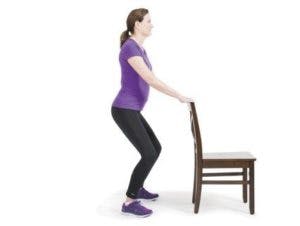The coronavirus outbreak has disrupted our lives and forced us to change our habits, including hindering most group fitness activities. Whether you like to do your own thing outside, take a class, or work one-on-one with a personal trainer, you might be feeling a little lost when it comes to staying active in your own home.
Exercising is important to our health in a variety of ways. It can improve strength, improve balance, give you more energy, prevent or delay disease, improve mood, and improve cognitive function. As long as your doctor says it’s safe for you to exercise, you should workout to improve the quality and increase the longevity of your life.
It may be daunting to start an exercise program at home, so we’ve broken down some exercises you can do with just one piece of equipment: a chair.
(Remember during this time that it’s important to keep your body moving and also to keep yourself safe, but never attempt an exercise routine without confirming with your doctor that it’s safe to do so. These chair exercises are a great way to strengthen your muscles and get your heart rate up in this time of “social distancing.”)
- Calf Raises

There are two ways to complete this exercise. First, you can sit upright in a chair with your feet flat on the floor hip-distance apart. Make sure you’re looking straight ahead and engage your core. Start with your right foot and lift your heel as high as you can and raise up on your toes as high as you can. Complete ten reps on each side for three sets.
Another way to complete calf raises is to stand behind the chair and hold onto it for balance. Stand with your feet shoulder-width apart. Complete the same movement of putting your weight on your toes and lifting your heels as high as you can, but this time, do it on both legs at the same time. Complete ten reps for three sets.
- Modified Push-Ups

Push-ups are an effective upper body exercise because they work so many muscles. By using a chair, you can decrease the difficulty of the exercise, decrease the impact on your joints avoid getting all the way down on the ground.
To perform this move, place the chair so that the seat is up against a wall to make sure that it’s not going to move while you complete the exercise. Stand behind the chair with your feet shoulder-width apart. You want to stand far enough away that you can extend your arms but close enough to feel comfortable and stable. Engage your core and keep your body as straight as possible. Slowly bend your elbows and lean your body forward to complete a push-up. Complete ten reps for three sets.
- Modified Planks
Planks are one of the best exercises to work your core. To complete it on the chair, start in the same position as the push-up. The seat of the chair should be against the wall, and you should stand behind the chair with your hands holding onto the top of the chair with your feet shoulder-width apart. Take a step back so your body is at a slight angle. Make sure your hips are aligned with your knees and shoulders. Hold the position for 10 to 60 seconds – however long you feel comfortable, and then return to standing. Complete three sets.
- Modified Squats

Squats are an effective lower body exercise that work your quads, glutes, and core. Stand behind the chair with your hands holding onto the top of your chair. Your feet should be about shoulder-width apart. Gently lower yourself down and imagine that you are sitting into a chair. The movement should be almost identical, but you can go however low you feel comfortable. Hold onto the chair for balance. Complete ten reps for three sets.
- Seated Leg Lifts

Seated leg lifts are a great exercise for your core and your legs. Sit at the edge of the chair with your back straight. Start with your legs shoulder-width apart extended in front of you with just your heels on the ground. Hold onto the chair for balance, and slowly lift your right leg up as high as you can without moving your torso. Hold it at the top for a second and then slowly lower your right leg back to the starting position. Then complete the move with your left leg. Complete ten reps on each side for three sets.
- Seated Shoulder Press

If you have a pair of light dumbbells, you can use those. You can also use objects you might find around your house, such as cans of soup or bottles of water – just make sure the two items you choose are identical in weight. You can also complete this exercise without weights. Start in seated position with your back straight, with elbows out to the side of your body. Your elbows should start below your shoulders with your wrist directly above your elbows. Your palms should be facing forward. Slowly extend your arms above your head as high as you can. At the top of the movement, they should be fully extended, but don’t lock your elbows. Slowly bring your elbows down keeping your elbows out. Complete ten reps for three sets.









